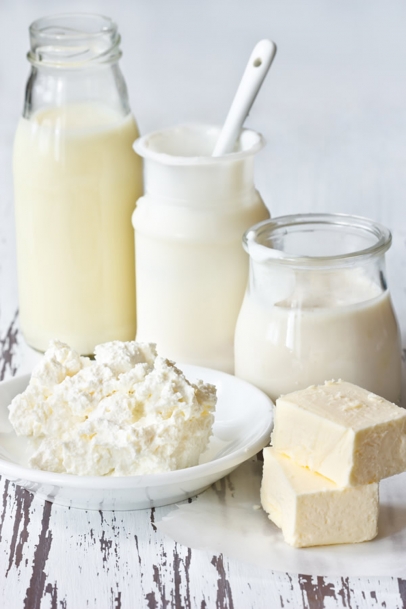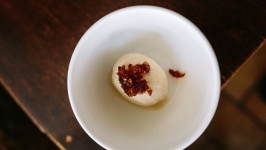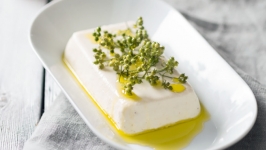Whatever Happened to Pure Cream?
Setting a Precedent for Further Food Adulteration
Milk, cream, and butter are staple foods for most Ontarians. For us dairy eaters, they're an indispensable part of our morning coffee and toast and are a ubiquitous ingredient in everything from popcorn to cake. And since dairy plays a central role in many diets, what would we do if it suddenly became unavailable?
When people lose access to their staple foods, it's a sign that something is awry; there may be social instability, natural disaster, famine, or war.
In 1984, George Orwell portrays the dystopian world as one where British staples like bread, gin, coffee, tea, and chocolate were almost impossible to acquire. Only the simulacra of these foods could be found: bread was “dark-coloured,” gin was “oily-tasting,” coffee was “filthy-tasting,” tea was really just blackberry leaves, and chocolate was “dull-brown crumbly stuff that tasted...like the smoke of a rubbish fire.”
While we’re a world away from the horrors Orwell chronicles, I have on occasion bought bread in Ontario that can solely be described as “dark-coloured.” Keeping in mind that food systems do suddenly collapse and they do slowly deteriorate over decades, we must be cautious and vigilant to protect against these possibilities.
There's an implicit assumption when you pick up a staple food item in the grocery store – a bottle of olive oil, a bag of rice, a carton of eggs – that you're holding something that contains a single ingredient. So ingrained is this unspoken agreement between shopper and manufacturer that we would almost feel silly to stop to read the ingredient label on one of these products.
Out of habit, I recently read the label on a carton of Sealtest cream and I was shocked – the cream contained carrageenan. Since when did they start adding carrageenan to cream? A look at several other brands indicated that, with the exception of a few certified-organic dairies, adulterated cream is the new normal.
What is carrageenan? What is it doing in our cream? And should we be concerned?
What is carrageenan?
Carrageenan is a thickener, similar to the flour or cornstarch home cooks might use to give more body to a sauce. Thickening agents, in a nutshell, act like long, hair-sized sponges (they're actually far narrower than a strand of hair) that absorb water, forming a loose mesh that makes liquids more viscous and stable (in effect, less likely to separate into layers). Carrageenan is derived from the slimy stuff that coats certain seaweeds, which is a fact I find more interesting than off-putting.
(Thickening agents are also called “gums” and they come in a wide variety, each having different application-specific benefits and drawbacks. Some gums you might recognize are guar, locust bean, and my personal favourite, xanthan.)
What is carrageenan doing in our cream?
On the surface, one might guess that dairy manufacturers are diluting cream and then artfully cutting it with additives to imitate that creamy mouth-feel. At least that's the hypothesis one dairy farmer gave me. Thankfully, that isn't the reason behind the carrageenan.
To understand why food processors are adding thickeners to our cream, you need to know about ultra-high-temperature (UHT) pasteurization. If you need reminding, pasteurization is the process of heating food to a temperature high enough to kill bacteria. It unfortunately kills beneficial bacteria, in addition to dangerous bacteria such as salmonella, E. coli, and listeria which might be present, and doing so conveniently extends shelf-life. UHT pasteurization, as the name implies, involves heating food to a temperature beyond that of regular pasteurization. For liquid dairy (yes, that's the industry's lingo), the difference between these two kinds of pasteurization is this: regular pasteurization means the liquid is heated to a high temperature (72° C) for a long period (16 seconds), and UHT pasteurization means the liquid is heated to a very high temperature (135° C) for a brief period (2 to 5 seconds).
Ontario's Health Protection and Promotion Act mandates regular pasteurization for grocery-store milk and cream, but not UHT pasteurization. So why are some liquid dairy products UHT pasteurized? One reason is to extend shelf-life. While regular pasteurization gives milk and cream a shelf-life of about three weeks, UHT pasteurization provides a shelf-life of about ten weeks. And if the UHT dairy is aseptically packaged (in a Tetra Pak, for example), you're looking at a six-month shelf-life. Furthermore, aseptically packaged dairy is shelf-stable, meaning it doesn't need refrigeration. Room-temperature UHT milk on the shelf might sound off-putting, but it's the norm in many countries; walk into a grocery store in France and you'll find milk and cream on the same shelf as cereal.
Keep in mind that supermarkets rely on processed foods – foods that are modified to last longer and hold up “better” during transport, in storage, and on the shelf. Milk and cream are highly perishable so UHT pasteurization is a godsend for supermarket managers, who regularly worry about losing product to spoilage because they are purchasing by the skid. Unfortunately, UHT pasteurization brings a few unwanted side-effects to cream.
First, UHT pasteurization causes the fat to separate from the milk as it sits on the store shelf. And here comes that “aha” moment: Carrageenan prevents this from happening because its mesh-like structure holds the milk and fat particles together. Second, the extreme heat used in UHT pasteurization affects the mouth-feel of cream, causing it to lose its silky texture. Carrageenan is added because it imitates cream's creaminess (carrageenan is how almond milks like Silk and So Good get that rich, thick, cream-like texture). And third, UHT pasteurization's high temperatures alter cream's functional properties, meaning it won't whip quite the same as regular pasteurized whipping cream. It can take longer to whip, result in a thinner consistency, and produce a less voluminous and less firm product. These drawbacks of UHT pasteurization are significant enough that an entire industry now exists to sell chemicals to dairy processors that make up for the functional properties lost from UHT pasteurization.
Note that milk has a lower fat content than cream, making milk less finicky and less susceptible to the drawbacks of UHT pasteurization. That's why you'll find additive-free UHT milk on the (un-refrigerated) grocery store shelf.
Should we be concerned?
Should we be concerned about carrageenan in our UHT-pasteurized cream, as well as other countless products that contain the additive? Here are five potential worries.
First, carrageenan might pose health risks. While it's a natural ingredient, not everything natural is good for you (like cobra venom, for example). Cornucopia, an organization dedicated to consumer health, released the 2016 Carrageenan Report, which argues that carrageenan is linked to gastrointestinal inflammation and colon cancer.
Second, carrageenan can ruin your dinner. I once spent all afternoon preparing a pork roast with a smoky apricot glaze. I added a dash of guar gum to thicken the sauce (I didn't realize there was already pectin in the jam, which is a gum) and I wound up with a succulent roast coated in a smoky apricot goop-glaze. Some thickeners have synergistic effects when mixed together. In other words, adding twice as much carrageenan will produce something twice as thick, but adding a dash of a different thickener might give you something exponentially thicker – so thick it might even end up as a gel.
Third, creaminess-enhanced cream is a product of our large-scale dairy industry and massive food distribution system. Centralized dairy factories that ship a spoilable product around a one-million-square-kilometre province rely on extending shelf-life. For those who believe in a decentralized and less industrial food system, it's not the carrageenan itself that's the problem; it's what the carrageenan facilitates. But then there are those who believe it's good to have cream that lasts longer in the fridge because it might lead to less food waste due to spoilage.
Fourth, adding anything to staple foods sets a precedent for further adulteration. If we permit carrageenan, what's next? Adding colours, flavours, or proteins to our cream? Might our cream one day resemble something from 1984? The downward spiral of adding additives has historically proved to be a real concern.
Fifth, some people believe that heating dairy to high temperatures destroys vitamins in the product, which makes intuitive sense. But University of Guelph milk expert Professor H. Douglas Goff explains in his (free!) The Dairy Science and Technology eBook that UHT pasteurization actually results in a lower loss of vitamins than regular pasteurization – duration, rather than intensity of heat, causes more damage.
To complicate matters, UHT milk often contains additives in addition to carrageenan. Read the ingredient label next time you're in the grocery store and you'll find a whole whack of other additives like mono- and diglycerides, cellulose gum, polysorbate, locust bean gum, and sodium phosphate, to name a few.
The verdict on cream with additives
Whether or not cream with additives is a bad thing is a decision you need to make for yourself based on your values. If you're okay with additives in your cream, keep buying brands like Sealtest, Natrel, and Lactantia. If you just want cream in your cream, stick with smaller brands with smaller processing and distribution chains, like Harmony Organic, Organic Meadow, Limestone Organic Creamery, or your local creamery. Or perhaps you sit somewhere between the two poles, choosing to buy the smaller brands as much as you can and resorting to the bigger brands from time to time.
Even if you don't want UHT-pasteurized cream in your home, it might make sense in other people’s homes. Longer shelf-life can lead to less spoilage and food waste. As well, transporting and shelving products that need refrigeration uses a ton of energy, which UHT aseptically-sealed dairy doesn't need. And in countries where energy is more expensive or less accessible, UHT pasteurization makes nutritious food more available.
As with all technology, it's neither good nor bad in and of itself; we can only use it in good or bad ways.









